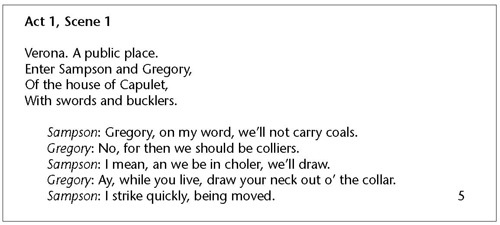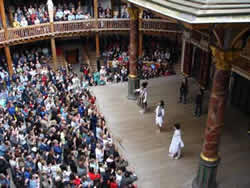Lesson 5.1B: Understanding a Shakespearean Play
 Although at first glance a Shakespeare play might appear intimidating and unfamiliar, learning some simple tips and techniques to access the play will make your reading experience easier. Your textbook has some features to help you understand some of the more difficult words and phrases that Shakespeare uses. As well, there are some commonalities in the structure among many of Shakespeare plays that, once understood, make the plays easier to read. Although at first glance a Shakespeare play might appear intimidating and unfamiliar, learning some simple tips and techniques to access the play will make your reading experience easier. Your textbook has some features to help you understand some of the more difficult words and phrases that Shakespeare uses. As well, there are some commonalities in the structure among many of Shakespeare plays that, once understood, make the plays easier to read.
The Tragic Plot
If you take a moment to flip through the text, you'll notice that the play has been divided into five major sections. These are called acts, and within each of these acts, there are a number of shorter scenes.
Think of acts like chapters in a book. These are the dividing points for the plot. The scenes within each act contain an important action or incident. Some scenes are short, while others might be quite long, but all are important to the whole story. Not all characters appear in all scenes. Shakespeare deliberately did this to give his actors a break, especially those who had major roles.
Going back to the previous module where you learned about how stories are organized, you'll also see that Shakespeare's plays reflect the basic plot structure found in many stories. In fact, most of Shakespeare's tragedies follow this same general structure, though some plots do vary from this structure.
 To view a breakdown, go to Will’s World and click on Will’s Play Plan. To view a breakdown, go to Will’s World and click on Will’s Play Plan.
Stage Directions
A Brief Word about Stage Directions
The first thing you'll notice before you read Romeo and Juliet is that this play is presented as a script.
Let's look at an example from the play's opening:

 As you look at the script, you see: As you look at the script, you see:
- the act, scene, and line numbers: these are consistent across all versions of the play, so no matter which version of Romeo and Juliet you have, Act I, Scene 1, Line 5 will always be the same!
- the setting
- the characters and their dialogue
- stage directions that indicate where the scene takes place, when characters are to enter and exit, and what these characters are to do on stage
- Square brackets that are used to indicate a stage direction. Here's a list:
- [Enter] = indicates a character (actor) to arrive on stage
- [Exit] = indicates a character (actor) is to leave the stage
- [They fight] = this tells us what the actors are to do and how they are to act on stage at this point
- [Aside] = spoken thoughts; as we don't know what a character is thinking, Shakespeare will sometimes tell us; these asides are not intended for everyone who is on stage; these words are meant for the audience, not the actors
- [Exeunt] = indicates two or more characters, or actors, are to leave the stage
Shakespeare's plays contain a minimum of stage directions; he was careful to use vivid language to indicate important things about characters, such as their actions, behaviour, and mannerisms.
Understanding Shakespeare’s Language
Because Shakespeare's language can be difficult to understand, most texts do provide readers with some guidance. In your text, there is a brief summary of the action to follow provided at the beginning of each scene. Read the summaries before you read the actual excerpts of the play. Reading the summaries first will help you focus on understanding the poetic language, colourful characters, and dramatic conflict in the play.
In the text of the play, notice that the character lines are spoken on the right page and definitions of unfamiliar words and translations of difficult lines are provided for you on the left. The left page will explain words and phrases that may have been more common in Shakespeare's day; translate difficult words or phrases; and generally explain anything that might prove challenging, including the references Shakespeare makes. Read these words and phrases carefully to help you better understand the play's action. Take advantage of the margin, if you have one, to write notes as you read!
| Definitions |
Character Lines |
Carry coals: to do a menial task; to put up with insults
Colliers: coal sellers; people who have to put up with insults.
Choler: anger |
Sampson: Gregory, on my word, we'll not carry coals.
Gregory: No, for then we should be colliers.
Sampson: I mean, an we be in choler, we'll draw.
Gregory: Ay, while you live, draw your neck out o' the collar.
Sampson: I strike quickly, being moved. |
 are the action words we use in writing. We sometimes add suffixes to verbs. The most common is the - ed ending to indicate past tense. In Shakespeare's plays, verbs will often end with an - est or - 'st suffix. If you cover up this suffix, you'll easily find the verb. For example, you might find the word “did'st.” This is the verb “did.” are the action words we use in writing. We sometimes add suffixes to verbs. The most common is the - ed ending to indicate past tense. In Shakespeare's plays, verbs will often end with an - est or - 'st suffix. If you cover up this suffix, you'll easily find the verb. For example, you might find the word “did'st.” This is the verb “did.”
We use pronouns to replace nouns. Pronouns include words like I, we, us, she, and his. The pronoun “you” was different in Shakespeare's day. You will see the following: thou (you, subject), thee (you, object), thy (your), and thine (yours).
Summary
Completing this lesson has helped you to:
- use features in your textbook to understand language and plot
- familiarize yourself with the stage directions
- learn to decode common terms used in Elizabethan English
- understand the structure of a Shakespearean tragedy
|

